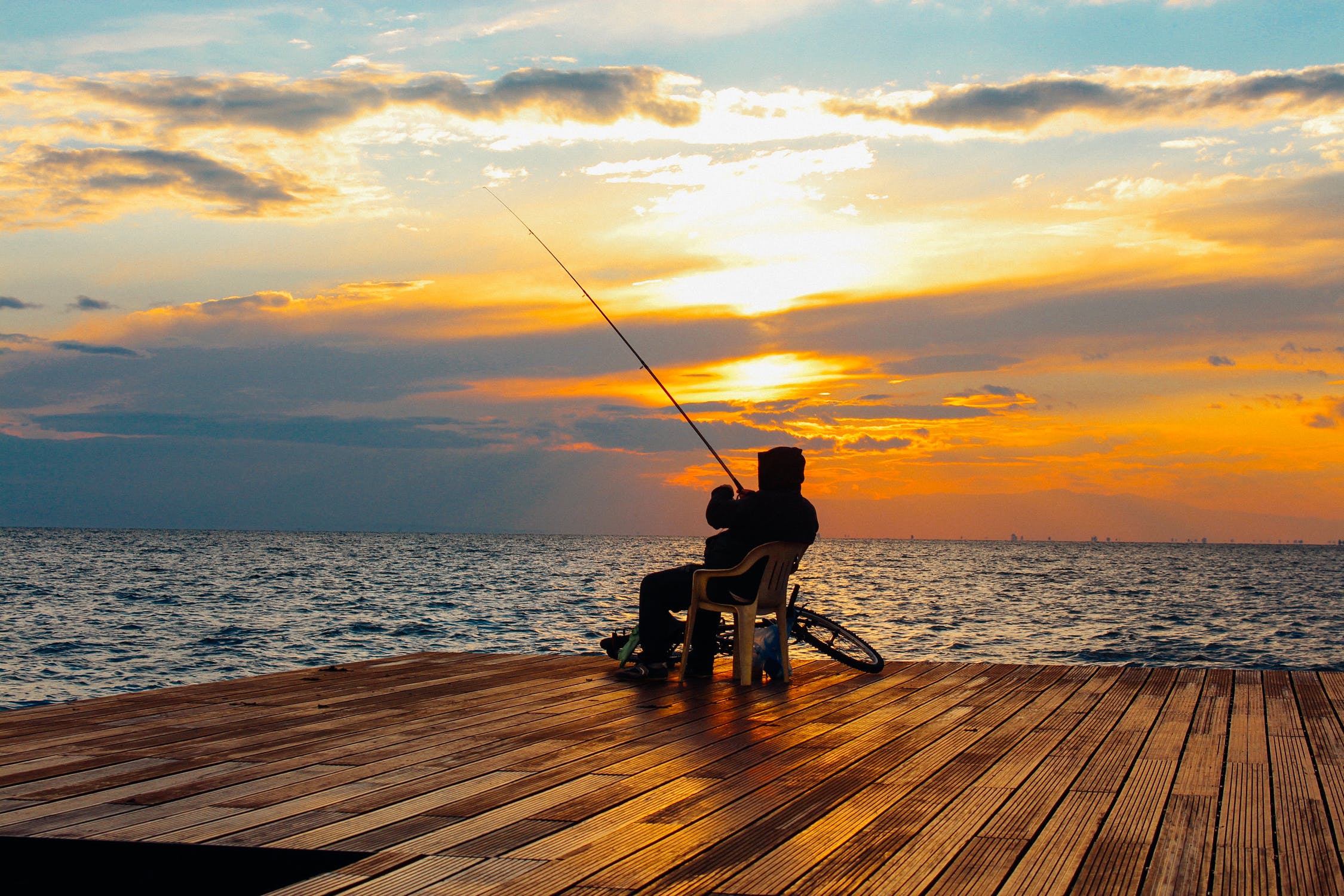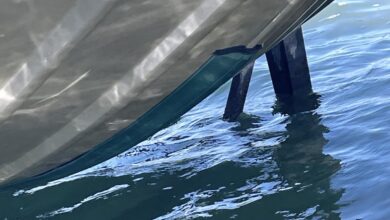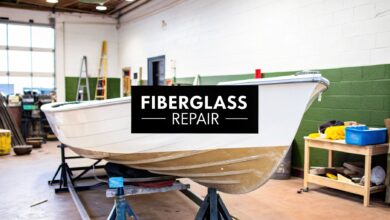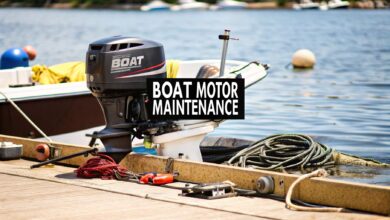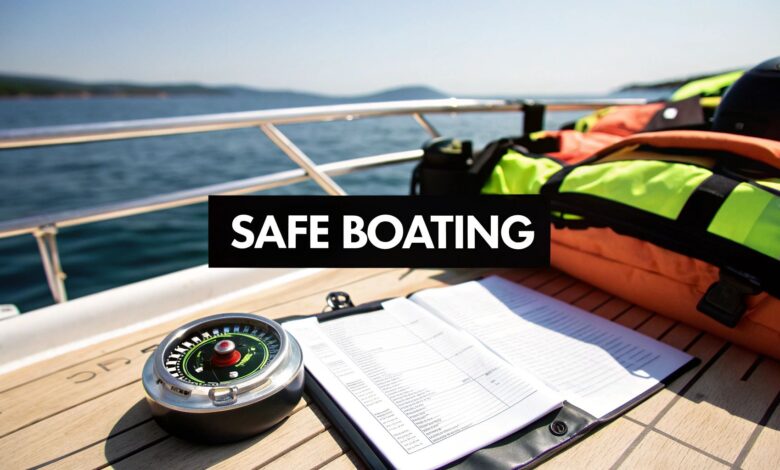
Every boater knows the basics: life jackets, a full tank of gas, and a sunny forecast. But genuine on-the-water safety extends far beyond this surface-level glance. The crucial difference between a memorable day and a potential disaster often lies in the overlooked details, the thorough checks and meticulous preparations made before the lines are ever cast off. This comprehensive safe boating checklist is designed to be more than just a simple list; it is a systematic guide to help you cultivate a professional mariner's mindset, ensuring you are prepared for anything the water throws your way.
We will dissect eight critical areas of preparedness, moving from standard regulatory requirements to the nuanced, real-world procedures that seasoned captains rely upon. Forget generic advice. This guide provides actionable steps and practical insights into everything from pre-launch mechanical inspections to executing a flawless emergency plan.
By integrating these specific protocols into your pre-departure routine, you will elevate your safety standards, build unshakable confidence at the helm, and guarantee that every voyage is as secure as it is enjoyable. Let's transform your pre-launch process from a simple chore into a powerful safety ritual that protects you, your passengers, and your vessel.
1. Life Jacket Inspection and Proper Fitting
Personal Flotation Devices (PFDs), commonly known as life jackets, are the single most important piece of equipment on your safe boating checklist. Their primary function is simple but life-saving: to keep you afloat if you unexpectedly end up in the water. Having enough life jackets on board is just the first step; ensuring they are the correct type, in good condition, and properly fitted for every passenger is what truly makes a difference.
A proper inspection involves more than a quick glance. Before each season, and periodically throughout, you must check for any signs of wear and tear. This includes looking for rips, frayed straps, broken buckles, or deteriorating foam. For inflatable PFDs, check the CO2 cylinder and the inflation mechanism to ensure they are armed and ready.
Actionable Fitting and Inspection Tips
Proper fit is non-negotiable, especially for children. A poorly fitted jacket can be as dangerous as no jacket at all.
- Test for Fit: With the jacket zipped and buckled, have the wearer raise their arms straight up. Grab the jacket by the shoulders and pull up. If it rides up past their chin and ears, it's too large.
- Children's PFDs: Always choose a life jacket designed for a child's weight. Ensure it has both a crotch strap to prevent it from slipping over their head and a large grab handle on the collar.
- Seasonal Water Test: The best way to confirm a PFD's buoyancy is to test it in shallow, controlled water at the start of the boating season. This ensures it still performs as expected and helps you and your passengers get comfortable wearing it.
- Consider Inflatables: For activities like fishing or long cruises where comfort is key, modern inflatable PFDs are an excellent option. They are less bulky and increase the likelihood that people will wear them consistently.
The following infographic highlights critical statistics that underscore the importance of vigilant life jacket use and maintenance.
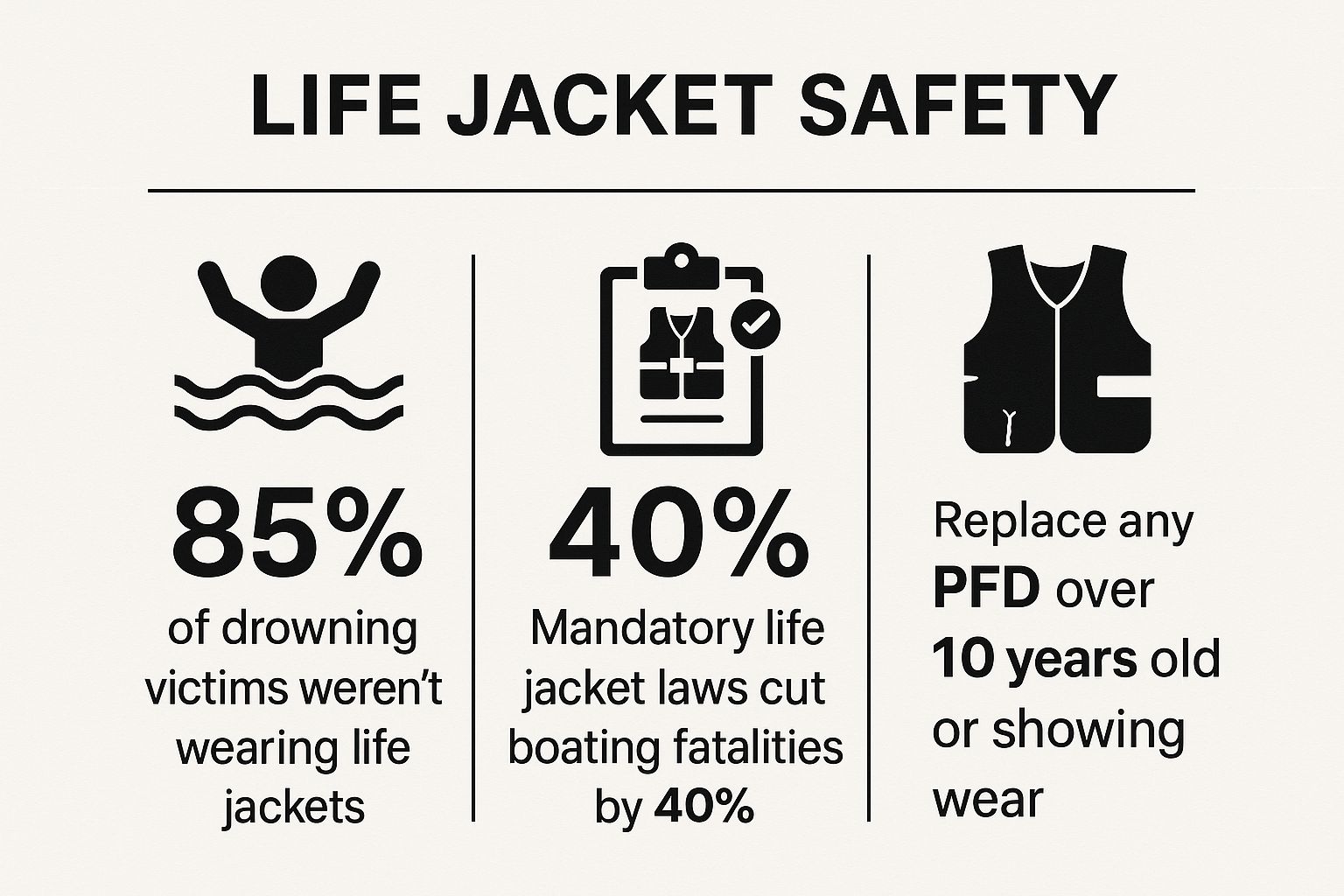
These statistics clearly show that wearing a life jacket dramatically increases survival rates and that diligent PFD maintenance is a key component of boating safety.
For a visual guide on how to select and fit the right life jacket for different activities and individuals, watch this helpful video from the U.S. Coast Guard.
2. Weather and Water Conditions Assessment
Checking the weather is a fundamental, non-negotiable step on any safe boating checklist. A comprehensive assessment goes far beyond a quick glance at a general forecast; it involves a detailed evaluation of marine-specific conditions for your planned route. This means understanding current and forecasted wind speed and direction, wave height, water temperature, visibility, and any local hazards or advisories. Ignoring this step is like setting sail blindfolded, as weather is one of the most powerful and unpredictable variables you will face on the water.
A thorough assessment informs every decision, from whether to leave the dock to what safety gear to have readily accessible. For example, Great Lakes mariners use specialized forecasting tools to prepare for the region's notoriously rapid weather shifts, while Florida boaters must plan their trips around predictable afternoon thunderstorms. The key is to match the forecast to the capabilities of your specific vessel and crew.
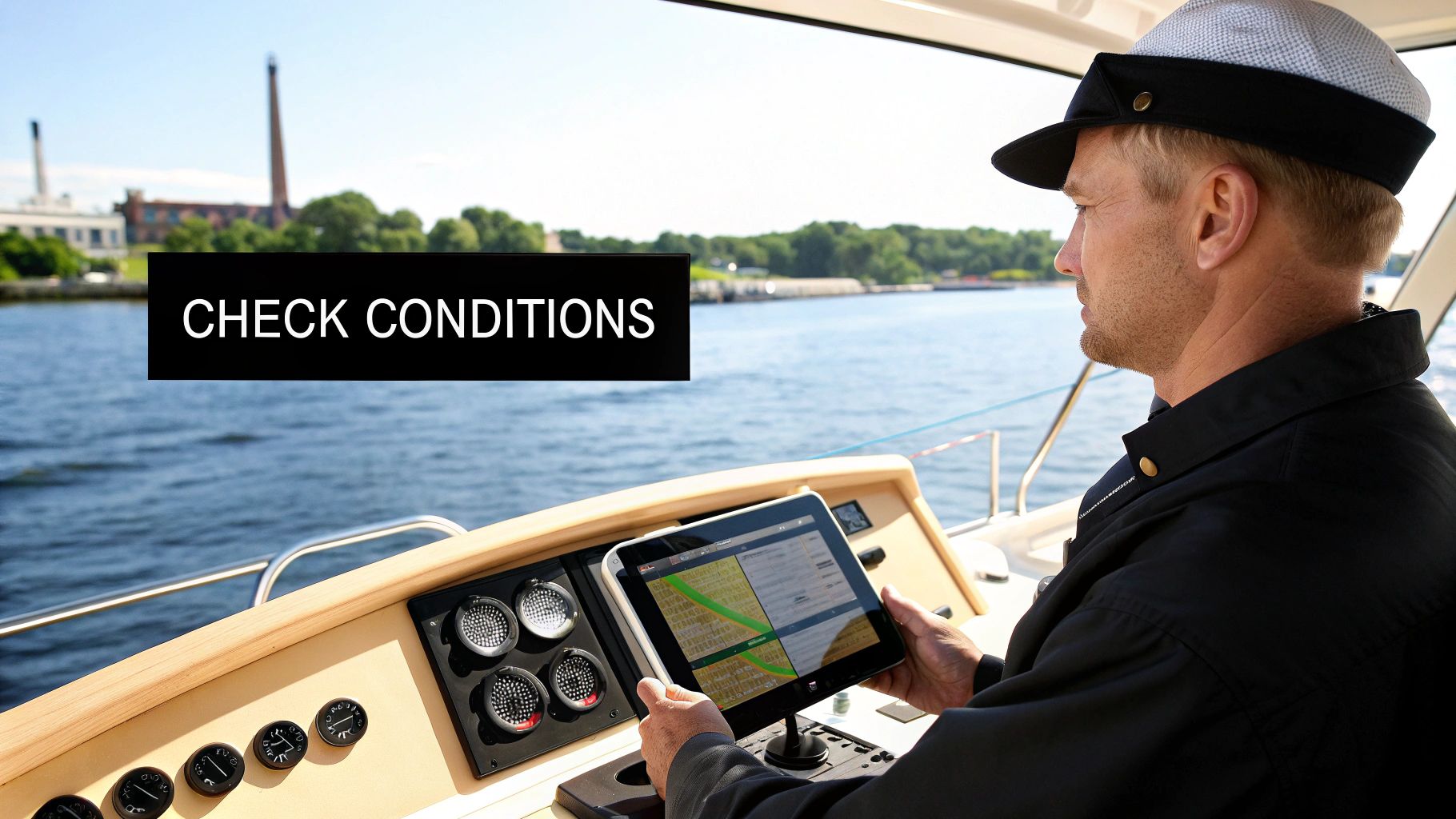
Actionable Weather and Water Monitoring Tips
A proactive approach to weather monitoring is crucial for safety. Conditions can change in an instant, and being prepared is your best defense against being caught off guard.
- Use Marine-Specific Sources: General weather apps are not sufficient. Use dedicated marine weather sources like the National Weather Service Marine Forecasts, or apps like Windy and SailFlow that provide detailed data on wind, waves, and tides.
- Have Multiple Backups: Rely on more than one source for your weather information. A VHF radio with weather channels is an essential backup for when cell service is unavailable.
- Know Your Local Patterns: Understand the typical seasonal and daily weather patterns for your area. This local knowledge helps you interpret forecasts with greater accuracy and anticipate changes.
- Monitor Continuously: Your weather check doesn't end at the dock. Keep an eye on the sky and monitor your weather sources throughout your trip. Be prepared to alter your course or return to shore immediately if conditions start to deteriorate beyond your comfort level or your vessel's limits.
The following video from the National Weather Service provides an excellent overview of how to interpret marine forecasts and understand the various alerts and warnings issued for boaters.
3. Navigation and Communication Equipment Check
Losing your way or being unable to call for help are scenarios that can turn a pleasant day on the water into a dangerous emergency. A thorough check of your navigation and communication equipment is a non-negotiable part of any safe boating checklist. This involves verifying that all primary and backup systems, from modern GPS units to traditional compasses and charts, are fully operational before you cast off. Reliable communication, primarily through a VHF radio, is your lifeline to assistance.
The U.S. Coast Guard, for instance, rescues approximately 15,000 people annually, with a significant portion of distress calls coming via VHF radio. This highlights the critical role that functioning equipment plays. Verifying your gear isn't just about powering it on; it’s about ensuring it performs its intended function correctly, from acquiring a satellite signal to transmitting a clear radio signal.
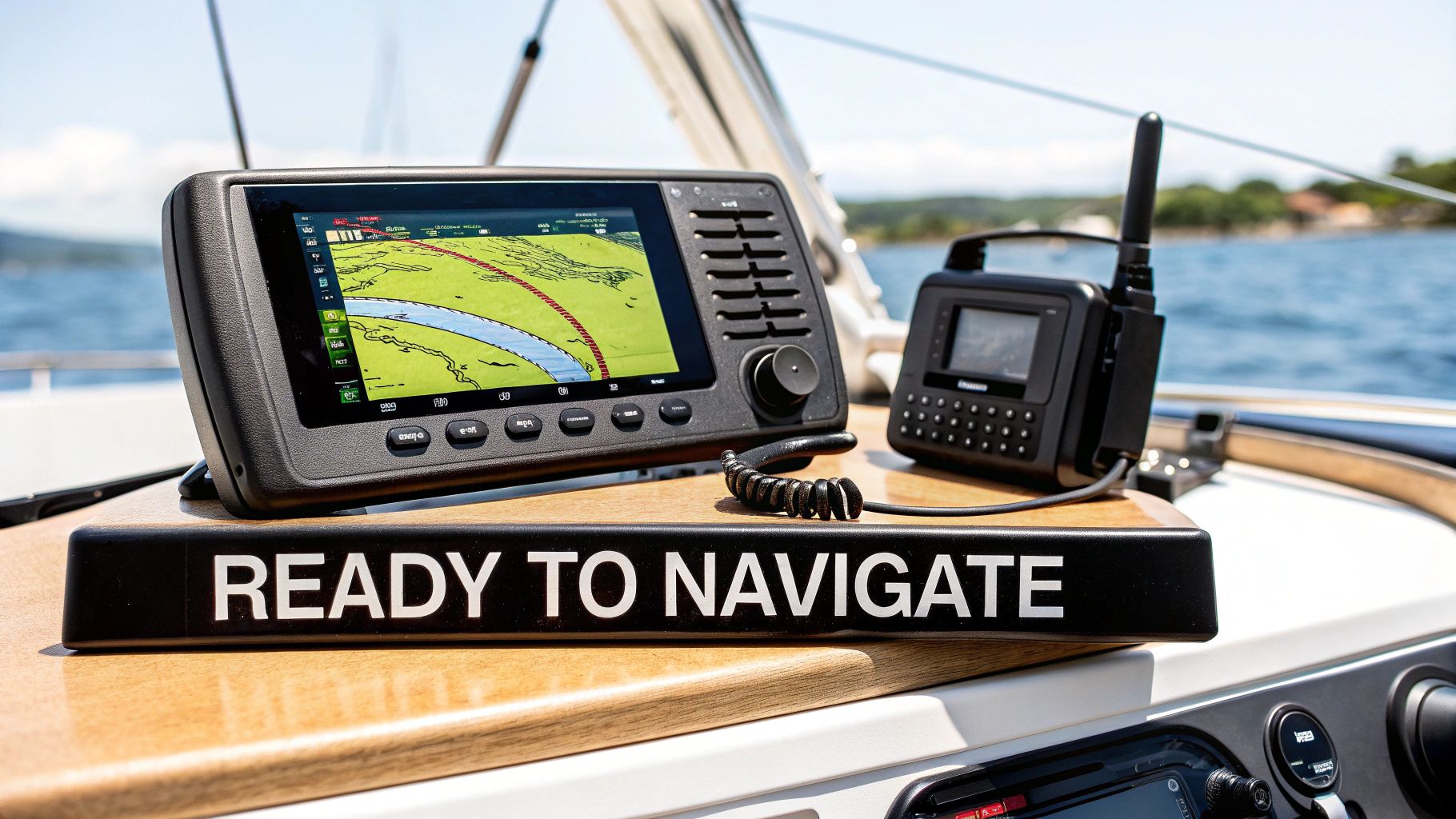
Actionable Equipment Check Tips
A pre-departure check ensures you can navigate with confidence and communicate effectively if needed. Modern electronics from manufacturers like Garmin and Raymarine are reliable, but they are not infallible.
- Comprehensive Systems Test: Don't just check for a power light. Confirm your GPS has a satellite lock, your VHF radio can transmit and receive clearly (use a radio check on a non-emergency channel), and your compass points accurately.
- Power Redundancy: Electronic devices are useless with a dead battery. Carry backup power sources, such as a portable power bank or extra batteries. Ensure all charging cables are on board and in good condition.
- Master the Basics: Technology can fail. Every boater should know how to use paper charts and a magnetic compass as a reliable backup. For a detailed walkthrough, you can explore this complete boat navigation guide for beginners.
- Prepare for Emergencies: Program essential waypoints into your GPS and have key contacts, including local emergency services and marinas, saved in your phone. Keep all portable electronics, like your phone and a handheld VHF, in waterproof cases or bags.
4. Fire Safety and Suppression Systems
A fire on board a vessel is one of the most terrifying and dangerous emergencies, as escape routes are extremely limited. Effective fire safety and suppression systems are a non-negotiable part of any safe boating checklist. This involves much more than simply having a fire extinguisher; it requires a comprehensive approach covering prevention, detection, and a well-rehearsed response plan. The combination of fuel, electrical systems, and flammable materials in a confined space makes a boat uniquely vulnerable.
According to BoatUS, a staggering 60% of all boat fires originate in the engine room, making it a critical area for protection. Proper fire safety preparation involves checking that all flammable materials are stored securely, fire extinguishers are functional and accessible, and any installed fire suppression systems are properly maintained. Knowing how to react in the first few seconds of a fire can be the difference between a minor incident and a total loss.
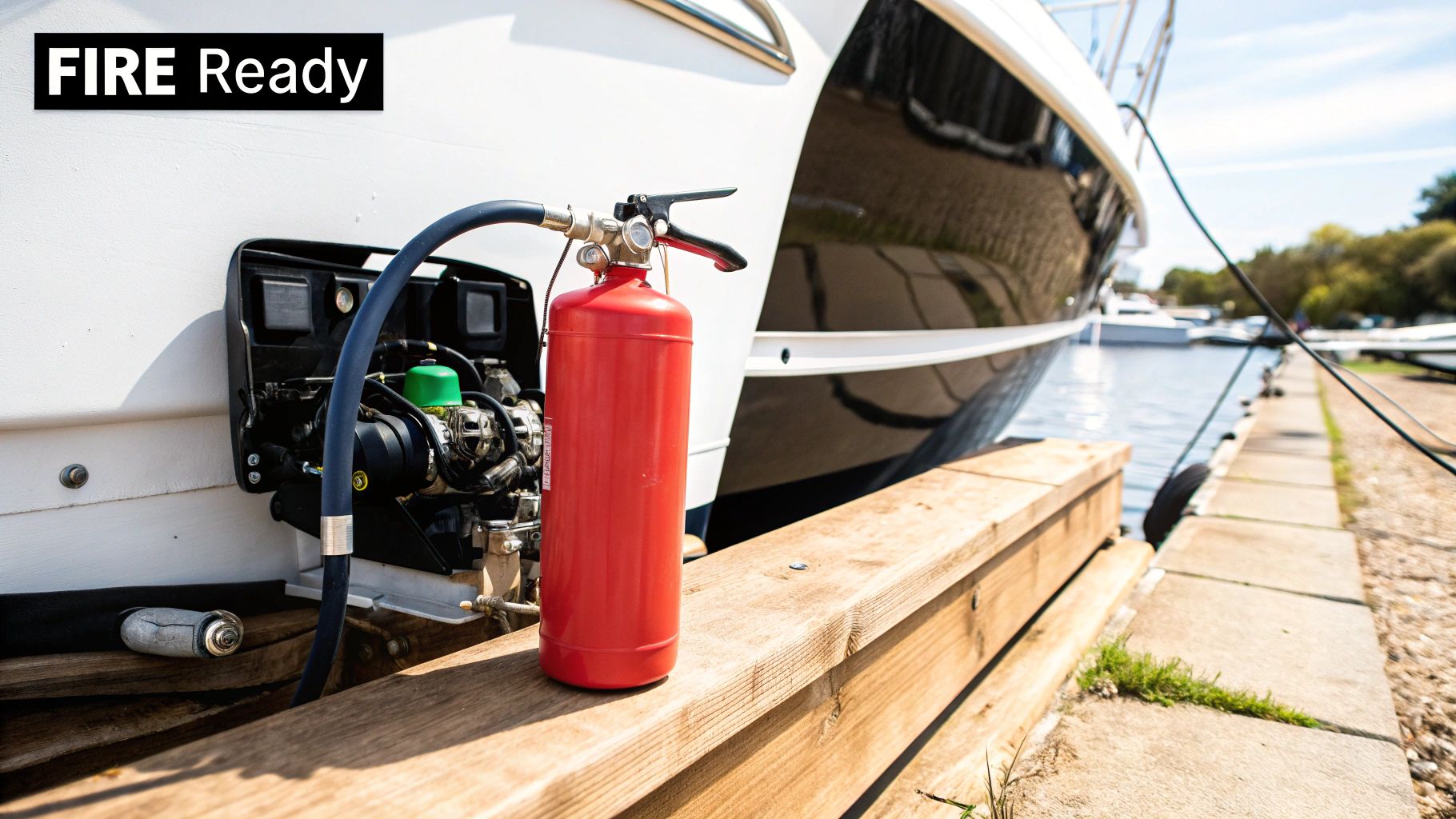
Actionable Fire Prevention and Response Tips
Proactive inspection and clear emergency procedures are essential for mitigating fire risk. An effective plan ensures everyone on board knows their role.
- Strategic Extinguisher Placement: Mount fire extinguishers in accessible locations near exits and away from potential fire sources like the galley or engine compartment. This ensures you can grab one on your way to an exit without moving toward the fire.
- Inspect and Maintain: Check the pressure gauges on your extinguishers monthly. Ensure they are in the green zone and have them professionally inspected and recharged according to the manufacturer's recommendations.
- Install Detectors: Consider installing smoke, heat, and carbon monoxide detectors, especially in the engine room and sleeping quarters. Automatic suppression systems, such as those made by Sea-Fire, have a high success rate when properly maintained.
- Know Your Fires: Never use water on a fuel or electrical fire; it will only spread the flames or create an electrocution hazard. Use the correct type of extinguisher (typically Class B for fuel and Class C for electrical).
- Conduct Fire Drills: Practice fire emergency procedures with your crew and passengers. A drill should cover locating extinguishers, shutting off fuel and electrical systems, and making an emergency call.
5. Engine and Mechanical Systems Inspection
A reliable engine and functional mechanical systems are the heart of your vessel, and a thorough pre-departure check is a non-negotiable part of any safe boating checklist. This preventative approach involves inspecting propulsion, steering, electrical systems, bilge pumps, and through-hull fittings to identify potential failures before they become dangerous emergencies on the water. A surprising number of distress calls are not for dramatic events but for preventable mechanical breakdowns.
The data underscores this reality: reports from the Coast Guard often show that a high percentage of assistance calls stem from mechanical failures that leave boaters stranded. Similarly, commercial vessels, which follow strict maintenance schedules, experience significantly fewer breakdowns. Towing services frequently report that simple issues, like cooling system failures, are among the most common problems they encounter, highlighting how basic checks can prevent a ruined day.
Actionable Mechanical Inspection Tips
Integrating these checks into your pre-launch routine can be the difference between a smooth trip and a call for a tow. A few minutes at the dock can save hours of trouble.
- Check Fluids and Belts: Before every single trip, check the engine oil level and note its color; milky oil can indicate water intrusion. Also, inspect engine belts for cracks and proper tension.
- Test the Bilge Pump: Manually test your bilge pumps by pouring a small amount of water into the bilge to ensure the float switch activates and the pump evacuates the water effectively.
- Inspect Cooling System: Once the engine is started at the dock, always check for a steady stream of water from the cooling system's outlet. A weak or nonexistent stream is an immediate red flag.
- Work the Steering: Turn the steering wheel from lock to lock to ensure it moves smoothly and without resistance. Check hydraulic fluid levels if applicable.
- Carry a Basic Toolkit: Always have a well-stocked toolkit with spare parts for common failures like fuel filters, spark plugs, and belts. Knowing how to perform basic repairs is an invaluable skill.
For a deeper dive into maintaining your boat's most critical component, you can learn more about comprehensive boat motor maintenance. This knowledge empowers you to handle minor issues and understand when to call a professional.
6. Emergency Equipment and First Aid Preparedness
When you're out on the water, professional medical help can be hours away, making onboard emergency readiness a crucial part of any safe boating checklist. This involves more than just a basic first aid kit; it means having a comprehensive system of medical supplies, survival gear, and signaling devices, coupled with a crew that knows how to use them. Being prepared for medical emergencies and survival situations can turn a potential catastrophe into a manageable incident.
A well-stocked first aid kit and accessible emergency equipment are non-negotiable. The U.S. Coast Guard responds to thousands of medical emergencies on the water annually, many of which are managed effectively by prepared boaters until help arrives. Properly equipped vessels have successfully treated severe issues, from deep lacerations to heart attacks, highlighting the life-saving potential of thorough preparation.
Actionable Emergency and First Aid Tips
Customizing your emergency supplies to your specific trip and crew is key. A short trip on a calm lake requires different gear than an offshore passage.
- Customize Your First Aid Kit: Go beyond a standard kit. Include specific medications for your crew's known conditions, like allergies or heart issues, and keep a waterproof card with their medical histories. Organizations like Ocean Medix offer specialized marine medical kits.
- Practice Emergency Drills: Regularly practice procedures with your crew, such as how to deploy a life raft, use a fire extinguisher, or operate the VHF radio to make a distress call. Familiarity under calm conditions builds confidence for a real emergency.
- Keep Equipment Accessible: Your first aid kit, fire extinguishers, and emergency beacons should be stored in a clearly marked, easily accessible location. In an emergency, you won't have time to search through storage lockers.
- Invest in Signaling Devices: For remote boating, visual distress signals may not be enough. Consider investing in an Emergency Position Indicating Radio Beacon (EPIRB) or a Personal Locator Beacon (PLB) from a brand like ACR Electronics to ensure you can be found.
These preparations are foundational to safe boating, ensuring you are self-reliant and capable of handling unexpected events. For information on preparing your vessel for more extreme scenarios, you can learn more about boat emergency preparedness on boating-articles.com.
7. Fuel Management and Hazardous Material Safety
Effective fuel management is a critical, yet often overlooked, part of any safe boating checklist. Proper planning, handling, and storage procedures are essential not only for ensuring you have enough fuel to get home but also for preventing fires, explosions, and environmental damage. A single mistake during fueling or a failure to properly ventilate can have catastrophic consequences, as fuel-related accidents account for a significant portion of recreational boating incidents.
Managing fuel goes beyond simply topping off the tank. It involves meticulous calculation, vigilant system checks, and strict adherence to safety protocols. This includes knowing your vessel's fuel consumption rate at different speeds, checking for leaks in fuel lines, and ensuring all hazardous materials, like cleaning solvents or spare oil, are stored securely in a well-ventilated area away from heat sources.
Actionable Fueling and Safety Tips
Adopting a systematic approach to fuel management will greatly enhance your safety and confidence on the water. Proper procedure is your best defense against fuel-related emergencies.
- Follow the One-Third Rule: This is a golden rule in boating. Plan to use one-third of your fuel to get to your destination, one-third to get back, and keep one-third in reserve for emergencies like bad weather or unexpected detours.
- Ventilate Before Starting: Always run your engine compartment's blower for at least four to five minutes before starting an inboard gasoline engine. After running the blower, perform a "sniff test" in the engine bay and bilge to check for any gasoline fumes.
- Practice Safe Fueling: Moor your boat securely, shut down all engines and electrical equipment, and get all passengers off the vessel. Keep the fuel nozzle in contact with the tank opening to prevent static sparks and never overfill the tank.
- Carry Spill Cleanup Materials: Keep absorbent pads or pillows on board specifically for fuel or oil spills. Promptly cleaning up even a small spill can prevent environmental fines, which can be substantial.
- Check Fuel Quality: Regularly inspect your fuel filter for water and sediment. Contaminated fuel can lead to engine failure at the worst possible moment. Systems from manufacturers like Racor are designed for this purpose.
8. Float Plan and Emergency Contact Procedures
A float plan is one of the most effective, yet simplest, items on your safe boating checklist. It is a detailed document that outlines your intended voyage, left with a responsible person on shore. This plan provides authorities with a starting point for search and rescue operations if you fail to return or check in as scheduled. It’s an essential safety net, ensuring someone knows your whereabouts and can act quickly in an emergency.
Leaving a float plan is not just for long offshore journeys; it’s a smart practice for any trip, even a short afternoon on a local lake. It contains critical information like your vessel's description, the number of people on board, your planned route, and your estimated time of return. According to the U.S. Coast Guard, having an accurate float plan dramatically reduces search and rescue time, which can be the difference between a successful rescue and a tragedy.
Actionable Float Plan and Contact Tips
Creating and filing a float plan should be a non-negotiable part of your pre-departure routine. It costs nothing but a few minutes of your time and provides invaluable peace of mind.
- Designate a Reliable Contact: Always leave your float plan with a responsible friend, family member, or marina staff. Do not file it directly with the Coast Guard, as they do not accept them. Instruct your contact on exactly when and who to call if you become overdue.
- Be Thorough with Details: Include your vessel's name, registration number, size, and color. List the names of all passengers, your planned destination, intended route, and alternate routes. Don’t forget to include communication equipment onboard, like your VHF radio call sign.
- Establish Clear Overdue Procedures: Specify a precise time when you are considered overdue. For example, instruct your contact to first try reaching you by phone and radio, and if there is no response within one hour of your ETA, they should then contact the Coast Guard.
- Update Your Plan: If your plans change while on the water, such as taking a different route or extending your trip, notify your shore contact. An inaccurate float plan can send search parties to the wrong location, wasting critical time.
For a comprehensive and easy-to-use template, you can download the official float plan form from the U.S. Coast Guard Auxiliary.
https://www.cgaux.org/public/floatplan.php
8-Point Safe Boating Checklist Comparison
| Item | Implementation Complexity 🔄 | Resource Requirements ⚡ | Expected Outcomes 📊 | Ideal Use Cases 💡 | Key Advantages ⭐ |
|---|---|---|---|---|---|
| Life Jacket Inspection and Proper Fitting | Low – routine inspections and fitting checks | Moderate – quality life jackets can be costly | High – significantly reduces drowning risk and legal compliance | All boating activities, especially passenger safety | Strong survival impact, legally mandated, comfort options |
| Weather and Water Conditions Assessment | Medium – requires monitoring multiple sources | Low to Moderate – apps and forecasting access | Prevents weather-related incidents, improves trip planning | Trips in variable or severe weather areas | Early hazard detection, trip timing, safety equipment prep |
| Navigation and Communication Equipment Check | Medium to High – needs technical knowledge | Moderate – devices and maintenance needed | Precise navigation, emergency communication | All vessels needing navigation and emergency contact | Enhances safety, emergency aid, collision avoidance |
| Fire Safety and Suppression Systems | Medium – equipment installation and checks | Moderate – extinguishers, detectors, training | Prevents vessel fire losses, injury reduction | Powered boats, especially with engine and galley areas | Fire prevention, emergency suppression, regulatory mandated |
| Engine and Mechanical Systems Inspection | High – requires mechanical skills and tools | Moderate to High – tools, spare parts, time | Reduces mechanical failures, improves reliability and efficiency | All motorized vessels requiring pre-trip readiness | Prevents breakdowns, extends equipment life, fuel efficiency |
| Emergency Equipment and First Aid Preparedness | Medium – kit stocking and crew training | Moderate – medical supplies and signaling devices | Enables medical and survival response, reduces panic | Remote or long trips, high-risk areas | Critical medical response, survival capability, rescue aid |
| Fuel Management and Hazardous Material Safety | Medium – planning and handling procedures | Moderate – fuels, ventilation, spill gear | Prevents fires/explosions, protects environment | All fuel-powered vessels and environmentally sensitive areas | Fire hazard reduction, environmental protection |
| Float Plan and Emergency Contact Procedures | Low – documentation and communication | Low – time and responsible contacts | Faster rescue, critical info provision | Trips with risk of delayed rescue or remote operations | Improves search efficiency, peace of mind, rescue facilitation |
Integrating Safety into Your Boating DNA
Navigating the waters offers an unparalleled sense of freedom and adventure, but that freedom is anchored in a deep commitment to preparation. The comprehensive safe boating checklist we've detailed isn't just a series of boxes to tick before casting off; it’s a foundational framework for responsible seamanship. By consistently moving through each critical point, from inspecting life jackets to finalizing your float plan, you are actively transforming your approach to boating. This isn't about fear; it's about empowerment.
True confidence on the water doesn’t come from a fast boat or a perfect day. It's forged through the quiet, diligent work you do at the dock. It’s the peace of mind knowing your fire extinguishers are charged, your navigation lights are functional, and your communication equipment is ready to perform. Each check you complete builds a layer of protection, not just for you, but for every person you invite aboard.
From Checklist to Culture
The ultimate goal is to move beyond the rote mechanics of a checklist and cultivate a genuine culture of safety. This shift occurs when these practices become so ingrained in your routine that they feel as natural as turning the key in the ignition. Think of it less as a chore and more as a ritual that honors the power and unpredictability of the water.
This culture extends beyond your own actions. It involves:
- Empowering Your Crew: Briefly explain the location of safety gear and key procedures to your passengers before you leave. A knowledgeable crew is your best asset in an emergency.
- Leading by Example: When you consistently wear your life jacket in rough conditions or diligently check the weather, you set a powerful standard for others.
- Continuous Learning: The marine environment is dynamic. Regulations change, technology evolves, and your skills can always be sharpened.
Mastering this safe boating checklist is your first and most critical step toward becoming a truly proficient captain. It’s the difference between simply operating a vessel and commanding it with foresight and authority. By internalizing these eight pillars, from mechanical systems to emergency preparedness, you equip yourself to handle unforeseen challenges calmly and effectively. This proactive mindset allows you to fully immerse yourself in the joy of the experience, secure in the knowledge that you are prepared for whatever lies beyond the horizon. Let safety become your second nature, the silent co-pilot on every memorable journey.
Ready to deepen your expertise beyond the checklist? The world of boating is vast, and continuous learning is the hallmark of a great captain. Explore the extensive resources at Boating Articles to find in-depth guides on advanced navigation, seasonal maintenance, and specialized safety protocols. Visit Boating Articles to continue your journey toward maritime mastery.
